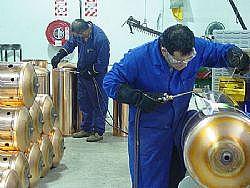WHAT originally started as an academic quest has emerged as a solid process with proven benefits for industries and companies involved in metal fabrication. When a bevy of New Zealand scientists developed the Aqua Gas process and announced they could split water into hydrogen and oxygen in a highly efficient manner, it seemed almost too good to be true. Consequently, their claim – to produce an on-demand hydrogen/oxygen burning gas system that effectively replaces the need for LPG and acetylene – was met with a good dose of skepticism. Since those early days, however, the scientists’ endeavours have been proven in the field. In fact, their process is now altering the status quo relating to the welding, brazing and cutting of metals. Where conventional methods such as oxy-acetylene welding used to be accepted as a given, organisations are now adopting the Aqua Gas process to harness the savings and quality that this process offers. It applies to a variety of situations, from metal fabrication to just about any other processes that employ LPG. "The entire process consists of a very compact mobile unit that provides fuel for cutting, welding and brazing, when and where it’s needed," explains Aqua Gas director Nigel Russell. When it burns, it produces water vapour and energy and is therefore completely non-toxic. Users adapt to it readily and are usually proficient in its use within half a day. Among the companies that use Aqua Gas is AGICO, an industrial gas supplier in Dubai, as well as major shipyards in Japan and, closer to home, water heating products manufacturer HJ Cooper. With an entire manufacturing unit dedicated to the production of copper water cylinders, they traditionally used oxy-acetylene for their extensive brazing needs. With a keen eye on rising operating costs, HJ Cooper decided to switch to Aqua Gas and installed three units in the hope of realising some benefits. "It was a great investment," explains HJ Cooper’s business development and operations manager Philip Bates. "We’ve taken $9000 off our annual gas bill and basically recouped the purchase costs in a very short time." While the cost savings are a compelling factor, a number of associated benefits have also made an impact on their operations. "It is completely clean burning so we don’t get a layer of soot everywhere," observes Bates. He appreciates the environmental issue from a Health and Safety point of view and also adds that there is a quantifiable secondary benefit because it saves on cleaning costs. "Our products are leaving the factory much cleaner; we’ve saved ourselves a whole lot of double handling." Given that more and more organisations are looking towards sustainable holistic concepts such as triple bottom line accounting, it goes without saying that the benefits derived from the Aqua Gas process are likely to be of increasing relevance. And those who are primarily concerned with remaining competitive? They will most certainly appreciate the opportunity to delete a recurring cost item from their operational budget. How does it work? Aqua Gas generators produce hydrogen and oxygen through the electrolysis of water. The process only requires water and electrical energy (applied to the electrodes in the electrolytic cell). It is based on the chemical equation: 2H2O + Energy > 2H2 + O2.
New technology makes industry inroads
General
Thursday, 22 June 2006






